|
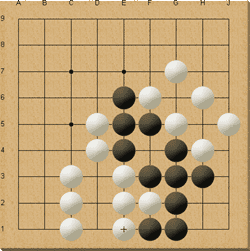 |
Origin
Go is a fascinating board game that originated in China more than 4,000 years ago. Also known as baduk, wei ch´i, weiqi, and igo, it is played today by millions of people all over the world. In Japan, Korea, China, and Taiwan, it is far more popular than chess is in the West, and professional players compete for large cash prizes.
Description
The board is a grid of 19 horizontal and 19 vertical lines forming 361 intersections. Smaller boards are often used, 13x13 sized, or even 9x9 for beginners. It is a game for two players, who have a large amount of black and white stones respectively.
Objective
The main objective is to get as much territory as possible with own stones, surrounding empty areas and capturing opponent stones.
Start of the game
The board is empty at the start of the game. The players can alternately play one move at a time, starting the player playing with black stones.
The option to play with handicap may be used: the strongest player gives some advantage to the opponent, between 2 and 9 stones; in these cases the weakest player uses black stones, the handicap stones are placed in certain points and the player who uses white stones must perform the first free move.
The handicap option may not be used in Ludoteka for rated games
How the game goes on
Moves entail in place a new stone on an empty point of the board. Placed stones may not be moved.
Liberties and territory
These are two main concepts to understand the game:
- The adjacent empty point to a stone or a group of stones of the same color is known as liberty.
- The groups of points surrounded by stones of one only color are territory of the player who uses that color.
Capturing stones
One group of stones is captured when it has not any liberty, this is to say, when all its surrounding points are occupied by enemy stones and there is not any empty inner point.
The image shows 6 white stones that may be captured inmediately:
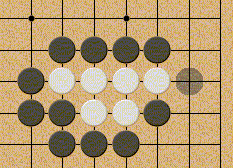
In particular, an isolated stone is captures when it is surrounded by for enemy stones; if it is placed on one of the sides or the corners of the board, 3 or 2 enemy stones are respectively enough to make the capture.
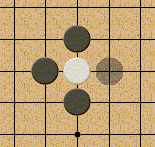
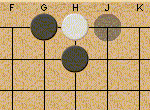
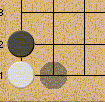
Captured pieces are removed from the board.
Limitations in the placing of the stones
There are two reasons that prevent the placing of the stones:
- Stones cannot commit suicide: the stone may not be placed on any point where it would remain without any liberty or being part of a group that would remain without any liberty, unless the placing of the stone results in the capture of some of the enemy stones.
The following image shows an empty point that may be not occupied by a white stone.
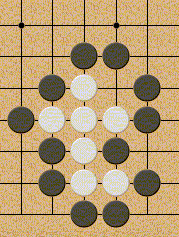
- The ko rule: the move is not allowed if the result would be a board position previously repeated during the game. This kind of situacion occurs frequently when an only stone is captured and the opponent has the option to place a new stone on the same point, capturing the same stone that realized the previous capture.
This is an example of a ko situacion:


End of the game
The end of the game is agreed between both players. Any of the players may pass instead of place a new stone, considering that there is no option to gain more territory, capture enemy stones or reduce the opponent´s territory.
The end of the game protocol starts when both players pass consecutively.
Dead and alive stones
At the end, players decide which stones would be certain captured if the game continues; those stones are called dead, and they are captured before counting the final score.
If both players do not agree in the identification of the dead and alive stones, the game resumes.
Playing at Ludoteka, the first player who passes must mark both players´s dead stones; the opponent may agree or mark and unmark stones to make another proposal. If any of the players agree one of the opponent´s proposal, the game is continued by the player who passed first.
If both players pass again inmediately in the resumption of the game, the count is made considering all the stones are alive.
Scores
Though basically the rules are the same, at least six rule sets are in use today in various parts of the world. The main aspect that varies in different rule sets is the way the count is made; we may simplify by saying that there are two ways to count:
- Area scoring: this is the method used in chinese rules. Player get one point for each stone placed on the board and each point of the own territory.
The advantages are that it is easier to understand for beginners, and the final result may not be influenced by possible disagreements between players. - Territory scoring: use in japanese rules.
This system is more often used. The advantage is that players have to take into account that playing in the own territory reduces their score. The main drawback is that, playing through the Internet, one of the players may always disagree in the decision of the dead and alive stones, reducing the opponent score by forcing him to make extra moves to perform the capture of the dead stones.
Both rule sets are availble in Ludoteka. When japanese rules are used and players disagree on the dead stones, the program compensates with the necessary extra points to the player who must place more stones to come into effect the capture of the opponent´s dead stones.
Komi
As usual in many board games, the player who makes the first move has some advantage; as compensation for this advantage, the player who uses white stones is given a certain amount of points, called komi.
This advantage is adjusted according to the rule set, the board size and the statistics of games played between expert players. It use to be a decimal value in order to avoid draws, and usually it is nearly 6.
Rated games is Ludoteka.com are always played with a 5.5 komi value.
Play now
Play online with some other players
Related links
Página personal de Carlos García
Copyright © 2001-2024 Ludoteka.com Jokosare S.L. All rights reserved - Disclaimer - Contact
